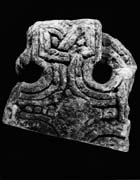Select a site alphabetically from the choices shown in the box below. Alternatively, browse sculptural examples using the Forward/Back buttons.
Chapters for this volume, along with copies of original in-text images, are available here.
Object type: Part of cross-head [1]
Measurements: H. 35.7 cm (14 in); W. 33.4 cm (13.2 in); D. 14.8 cm (5.8 in)
Stone type: Coarse-grained (with rounded grains), non-calcareous, very pale brown (10YR 8/3) sandstone; deltaic channel sandstone, Middle Jurassic or, more probably, decalcified Middle? Calcereous Grit; see no. 1
Plate numbers in printed volume: 526-530
Corpus volume reference: Vol 3 p. 156-157
(There may be more views or larger images available for this item. Click on the thumbnail image to view.)
The piece is from a ring-headed cross of the Ryedale type with stepped crest to the rim of the ring. The arm type is A11, with ring type 1(a).
A (broad): A narrow, flat perimeter moulding is continuous on the cross-arms. In the centre is a flat circular boss around which a broad median-incised strand moves, clinging to the arm-pits and forming Stafford knot terminals in the arm ends (only the upper vertical limb survives completely). Within the spaces of the knot are single pellet fillers; a row of pellets lines the innermost strip of the lateral arms, and a single pellet lies above the boss. The ring is complete on the right but only a stump survives on the left. The ring has contoured, narrow, flat mouldings, within which are the remains of a step pattern. The outer rim, or crest, has a narrow, flat edge moulding at the top, above incised chevrons.
B (narrow): Broken away except for the top of the wheel. This has a narrow flat edge moulding flanking a run of what was probably a three-strand plain plait, using narrow, flat strands.
C (broad): As face A though considerably more damaged. There is an additional pellet filler between the loops of the Stafford Knot in the arm.
D (narrow): Broken away.
E (top): The top of the upper vertical arm has a narrow, flat perimeter moulding round its rectangle. It contains a confused knot, based upon two closed circuit loops, using broad, median-incised strands.
This cross-head is the product of the same hand as Middleton 2 and 5 and the Levisham ring-head (no. 4). All are cut in parallel planes with stepped edges, and are characterized by bungled interlace and pellet fillers. The sculptor also decorated the inner arc of the ring, which he treated in an angular, stepped manner. In general terms, the piece is related to other ring-heads in Ryedale, notably on account of its stepped wheel.



